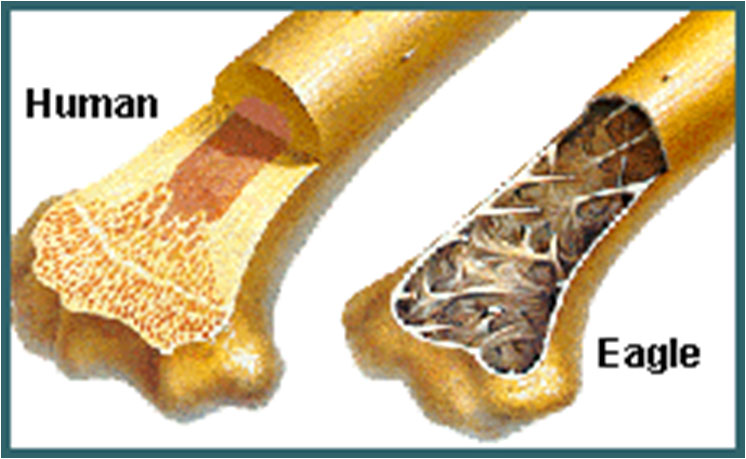Excellent study material for all civil services aspirants - begin learning - Kar ke dikhayenge!
BIRDS – ORIGIN, EVOLUTION AND SUCCESS
Read more on - Polity | Economy | Schemes | S&T | Environment
- Gravity acts on birds, like on everything else. To minimize the effects of gravity, birds are adapted to be as light as possible
- These are some adaptations that help make birds light – Hollow bones and Feathers
- Bird babies don't grow and develop inside the mothers' bodies. They develop in eggs outside their mothers' bodies
- Birds eat foods that are very high in usable calories so they get as many calories as possible from from a small amount of food
- Seeds, fruits, and meat (from prey) are the main food items for birds.
- Virtually no birds (except the Hoatzin, South America) eat leaves, which take a long time to digest. Their efficient digestion allows birds to get rid of useless weight
- Birds don't have bladders. A bird urinates as soon as it has to, getting rid of the useless weight
- Birds don't have teeth or a nose, which are heavy and would be too far forward. To grind their food, their stomachs have a gizzard near their center of gravity. They use their mouth and the nostrils located on the top of their lightweight beak to breathe. (Their nostrils are also used for smelling. Older bird books say most birds can't smell, but current research proves that many birds have at least some sense of smell.)
- Their tail and wing bones are very short, attached to sometimes long (but always very light) feathers.
- Bird lungs don't fill up with a lot of air like ours do. All vertebrate lungs (including birds') need to be placed near the heart. Our huge, lightweight lungs set in our chest work fine for us, but birds need their heaviest organs in their chests. So their lungs, which can hold very little air, are flat and sit against their back ribs. The air birds' breathe in flows through the lungs into big balloon-like air sacs that fill much of their lower abdomen, behind their center of gravity. When they breathe out, the air flows back through the lungs through different passages. Their lungs are VERY efficient at pulling out oxygen (which they need in great quantity) as streams of air go in and out.
- A bat has a much more flexible wing structure.
- It is like a human arm and hand, but with a thin membrane of skin (the patagium) extending between the "hand" and the body, and between each finger bone
- Bats can move the wing like a hand, essentially "swimming" through the air
- Considering that the avian respiratory system served dinosaurs well 175-250 million years ago, at a period when low environmental oxygen and high temperature affected the planet, this combination of flow-through ventilation (uni- and bidirectional) and crosscurrent exchange allows birds to extract up to 160% more oxygen from the air than mammals can (i.e. up to 260% of mammalian levels.
- The origin of birds is now one of the best understood major transitions in the history of life.
- The first hint that birds evolved from reptiles appeared in 1861, only a few years after Darwin published On the Origin of Species, with the discovery of an exquisite skeleton of a Late Jurassic (ca. 150 million year old) bird from Germany
- Named Archaeopteryx by British anatomist Richard Owen, this fossil possessed a curious mixture of classic bird features, such as feathers and wings, but also retained sharp claws on the hands, a long bony tail, and other reptilian characteristics
- By the 1990s the vast majority of paleontologists accepted the dinosaur–bird link, but many ornithologists remained skeptical.
- The discovery in the late 1990s in China of fossils from thousands of bona fide dinosaurs covered in feathers provided the most definitive visual evidence for the dinosaur–bird link, convincing most of the remaining skeptics
- It is now widely accepted, even by ornithologists, that birds evolved from dinosaurs
- Birds evolved from dinosaurs, and therefore are dinosaurs, in the same way that humans are a type of mammal
- Birds are within the theropod dinosaurs, the major subgroup of mostly carnivorous species that includes the behemoths Tyrannosaurus and Allosaurus, but also smaller and much more bird-like species such as Velociraptor, Deinonychus, and Troodon
- Birds are members of exclusive theropod subgroups: Coelurosauria, Maniraptora, and Paraves
- Their very closest relatives are the mostly small-bodied, feathered, large-brained dromaeosaurids and troodontids, exemplified by the well-known Velociraptor
- Modern birds achieved their enormous diversity over a more than 150 million year evolutionary journey, which began with their divergence from theropod dinosaurs, continued with the gradual and piecemeal acquisition of a flight-worthy body plan, and involved two bursts of diversification: first in the Mesozoic when a small, feathered, winged dinosaur was fully assembled, and second when surviving species had the freedom to thrive after the end-Cretaceous extinction
- True modern birds — members of the crown group Neornithes— are a mostly post-Cretaceous radiation, although there is some fossil evidence for Cretaceous species
* Content sourced from free internet sources (publications, PIB site, international sites, etc.). Take your own subscriptions. Copyrights acknowledged.

























COMMENTS